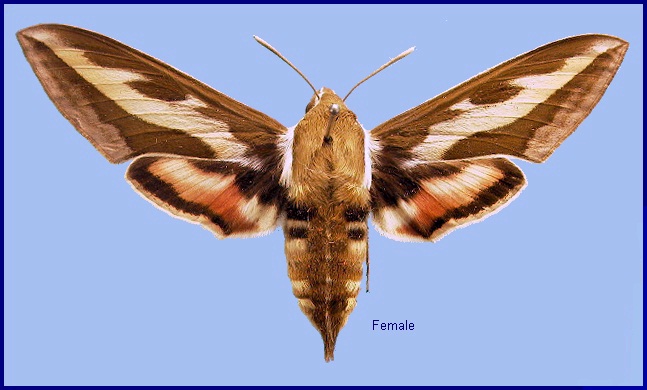
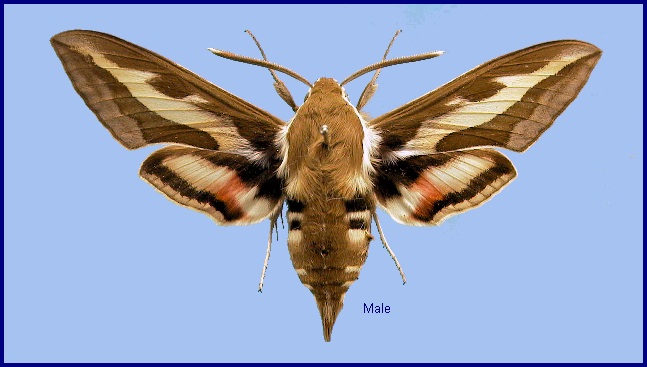
Sphinx gallii von Rottemburg, 1775, Naturforscher, Halle 7: 107. Type locality: Germany.
Synonym. Sphinx gallii von Rottemburg, 1775.
Synonym. Sphinx galli Denis & Schiffermüller, 1775.
Synonym. Sphinx epilobii Harris, 1833.
Synonym. Deilephila intermedia Kirby, 1837, Fauna Boreali-Americana 4: 302.
Synonym. Deilephila chamaenerii Harris, 1839.
Synonym. Deilephila oxybaphi Clemens, 1859.
Synonym. Deilephila canadensis Guenée, 1868.
Synonym. Deilephila galii Kirby, 1892.
Synonym. Celerio gallii grisea Tutt, 1904.
Synonym. Celerio gallii incompleta Tutt, 1904.
Synonym. Celerio gallii pallida Tutt, 1904.
Synonym. Celerio gallii stricta Tutt, 1904.
Synonym. Celerio galii Kuznetsova, 1906.
Synonym. Deilephila gallii dentata Gschwandner, 1912.
Synonym. Deilephila gallii lutea Gschwandner, 1912.
Synonym. Deilephila gallii maculifera Klemensiewicz, 1912.
Synonym. Deilephila gallii cuspidata Fritsch, 1916.
Synonym. Celerio gallii flavescens Closs, 1920.
Synonym. Celerio gallii scholzi Stephan, 1924.
Synonym. Celerio gallii chishimana Matsumura, 1929, Insecta matsum. 3: 166.
Synonym. Celerio gallii sachaliensis Matsumura, 1929, Insecta matsum. 3: 166.
Synonym. Celerio gallii grisescens Bandermann, 1932.
Synonym. Celerio gallii testacea (Wladasch, 1933).
Synonym. Celerio gallii postrufescens Lempke, 1959.
Synonym. Celerio galii nepalensis Daniel, 1961, Veröff. zool. Staatssamml. Münch. 6: 160.
Synonym. Celerio gallii heliophila Eichler, 1971.
Synonym. Celerio galii [sic] tibetanica Eichler, 1971, Ent. Abh. Mus. Tierk. Dresden 38: 315. Type locality: [China,] NW Tibet [Xizang], Lanak-la, 5400m.
(Note. The study of Hundsdoerfer et al. (2017) confirms the previously proposed synonymy of Hyles nepalensis (Daniel, 1960), Hyles gallii intermedia (Kirby, 1837) and Hyles gallii tibetanica (Eichler, 1971) with Hyles gallii, i.e. they are not separate species, or even subspecies.)
[Further details on this species in Japan, as well as photos of many stages, can be found on Digital Moths of Japan.]
Wingspan: 65--85mm. Forewing costal area brown, sharply denned; median area yellowish; marginal band grey. Hindwing yellow, with a tinge of pink; a red patch behind middle, the red colour often extending along the black basal area and the black submarginal band. Underside with no trace of red. First protarsal segment with the external row of spines complete, double at base, the spines little prolonged. Pulvillus present. Antenna white above only at end. Tegula without white upper fringe; abdominal side-patches as in Hyles nervosa, but dorsum of abdomen with a white spot on each segment, and white fringes of tergites broken on dorsum (Bell & Scott, 1937).
The well-defined, pale oblique median stripe on the forewing distinguishes Hyles gallii from other similar members of the genus. There is very little variation: in f. grisea Tutt, the normally olive brown forewing areas are greyish and the red is absent from the hindwing discal band; in f. pallida Tutt, the forewing median stripe is white instead of yellowish.
Populations from more arid regions tend to be paler in colour, those from cooler and wetter areas are darker. As in Hyles nicaea sheljuzkoi (Dublitzky, 1928) and Hyles hippophaes bienerti (Staudinger, 1874), many individuals from Kashmir and the Pamirs are much larger and paler than is normal.
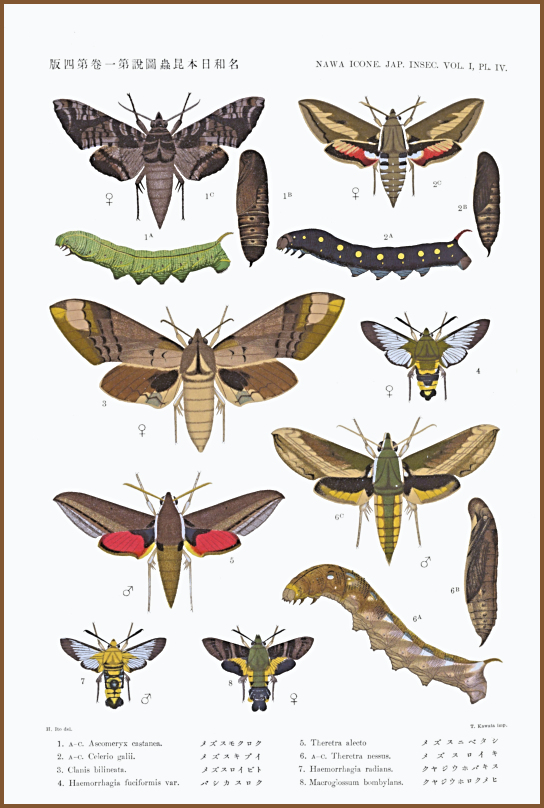

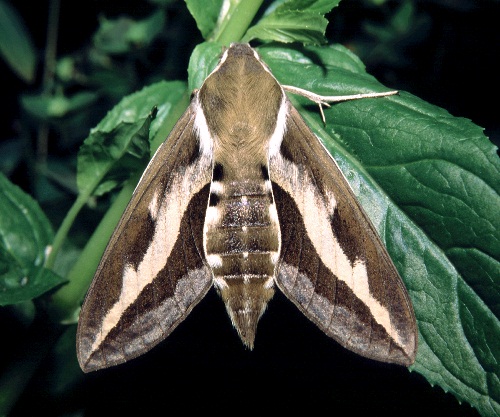
Frequents rough common-land, roadside verges, meadow edges and, especially, clear-felled areas in mountain forests where Epilobium and Galium are present.
A strong flyer, it becomes active at dusk and again at dawn, when it searches for flowers from which it feeds avidly. Pairing rarely takes place before early morning and lasts approximately two hours. After extra feeding, females commence egg-laying one or two days later, continuing to do so for up to ten days. Both sexes are attracted to light.
If threatened and feeling at risk, resting adults will drop to the ground, raise their wings, press their antennae together frontad, arch their bodies, run and hop around, while flicking their forewings back and fourth to expose the red patch on the hindwings. Although not so extreme, this behaviour is also seen in many other sphingidae, especially Sphinx ligustri Linnaeus, 1758 and other members of the genus Hyles.
China: iv (Shanghai); v-vii (Yining/Gulja); 5.v-2.vi (Yanqing); vi (Xizang/Tibet, 3300-4500m); 20.vi-15.vii (Shihezi). North Korea: vii (North Hamgyong Province). South Korea: viii (South Cholla Province). Japan: 18.vi (Honshu); 6.vi-5.ix (Hokkaido). Mongolia: 9-30.vi (Khovd Province); 1-27.vii (Bayan-Ölgiy Province; Khovd Province; Gov'-Altai Province). Russia: 21.v-vii (Siberia); 25.v-25.vi (Khabarovskiy Krai); vi-vii (Primorskiy Krai); 1.vii (Magadan Oblast); 10-11.vii (Khabarovskiy Krai, Botchinskii Nature Reserve); 19-20.vii (Khabarovskiy Krai; East Yakutia); vii (Altai); viii (Altai); 10.viii-2.ix (Khabarovskiy Krai); 3-9.ix (Primorskiy Krai).
In northeastern China, there are several generations a year and adults fly between April and September (Yang, 1978). In Xizang/Tibet and Qinghai, adults fly in May and July (Chu & Wang, 1982).
Univoltine in Siberia during late June and July. Although Hyles gallii generally flies in July, in some years individuals can be found as early as mid June and as late as mid August. However, in some warm years there are two broods at Khabarovsk (Dubatolov, pers. comm. 2010).
OVUM: Greenish-blue, almost sperical (1.0 x 1.1mm), shiny and smooth, with a depression dorsally. Deposited on the leaves of the hostplant or sometimes, as in the case of Galium, on the flowers, with up to four or five per plant.
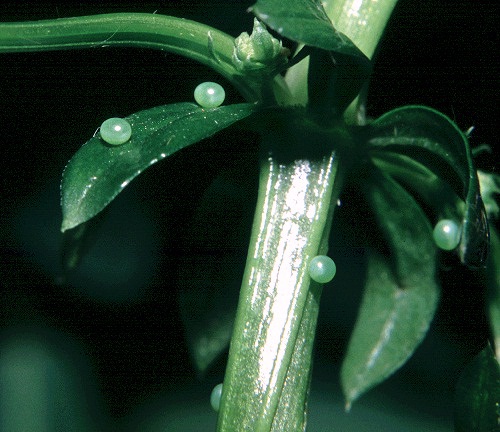
LARVA: Full-fed 75--90mm. Polymorphic: one form mainly black. Shape as in others of the genus; horn of medium length, down-curved.
Newly hatched, the 3--4mm-long larva is clear green with a number of yellow longitudinal lines. With growth, the green usually darkens to dark olive (or sometimes brown or black) and all lines except the dorso-lateral fade. This line gradually breaks up, to be replaced in the final instar by a row of startling, yellow or reddish eye-spots. The ventral surface in nearly all individuals is pinkish, and the head and horn red. In black larvae, both ventral and dorsal surfaces are of the same colour and the reduced eye-spots may be red. All colour forms bear small yellow spots laterally and ventro-laterally, which may be extensive or barely visible.
Initially, it feeds during the day and night, resting at intervals along the midrib under a leaf; when larger, larvae tend to retire low down on a plant by day, crawling up at dusk to feed. However, during wet weather fully-grown individuals may be seen in the daytime. The number of larvae varies greatly from year to year, perhaps due to the weather or to the high rate of parasitism.
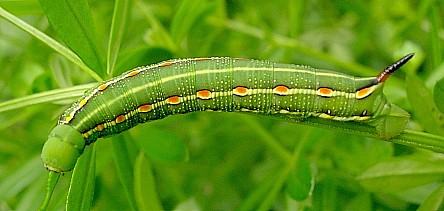
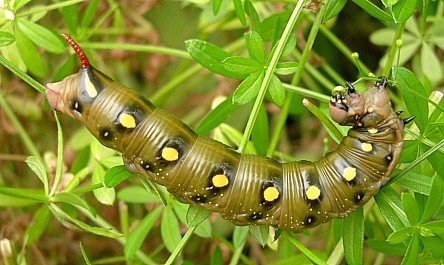
PUPA: 40--45mm. Colour of head, thorax and wing-case yellowish brown with darker vermiculate markings; abdomen reddish brown; spiracles and cremaster black. Very similar to that of Hyles euphorbiae, although those produced by black larvae often have black wings and heavy black speckling on the abdomen. Tongue-case not prominent; antenna longer than fore leg, reaching middle of wing-case; a small coxal piece. Surface dull and smooth. Cremaster large, bent towards the venter. Encased in a loosely spun silk net amongst ground litter. Those formed before mid-July usually hatch the same year, giving rise to a second generation. Overwinters as pupa.
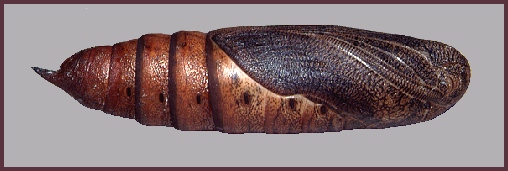
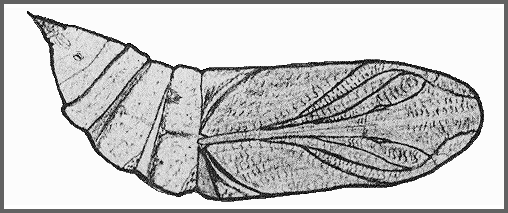
Larval hostplants. Unknown in China, but elsewhere feeds mainly on Rubiaceae and Onagraceae, especially Galium and Epilobium. There are also records from Acalypha, Betula, Euphorbia, Geranium, Impatiens, Malus, Plantago, Portulaca, Rosa, Rumex, Salix, Spiraea, Syringa and Vitis. Recorded on Chenopodium album and Galium in Mongolia (Zagorinskiy, Gorbunov & Puntsagdulam, 2010), and Galium verum var. asiaticum and Epilobium angustifolium in Korea (Park et al., 1999).
Unknown for the region.
China: Xinjiang (Shihezi; Ürümqi; Yining/Gulja; Xiaerxili Natural Reserve, near Bole City, Bortala Mongol Autonomous Prefecture; Altai Mountains); Nei Mongol (Ergun Youqi; Zalantun/Butha Qi; Hohhot); Heilongjiang; Jilin; Liaoning; Hebei (Laishui; Baishishan); Beijing (Yanqing; Wudaogou); Shandong; Shaanxi; Qinghai; Gansu; Shanghai; ?Zhejiang; Yunnan (Gezancun); southern Xizang/Tibet (Arun Valley; ??Cho Dzong; Lhasa; Lung Xian, 3100m; Nyalam, 2250-4000m; Nyingchi/Linzhi, Namjagbarwa area, 3050m; Qamdo; Rinbung, 3900m; Xigazê, 3836m; Yi'ong, 2700m; Mêdog/Pemako County) (Wang, 1988).
Mongolia: Bayan-Ölgiy Province (Kobdo River valley, 20km SW Tsengel, 1900-2200m (48°49'N 88°59'E); Kara-Irtys basin, middle stream of Elt river, 2100-2300m; Khuraj-Modny-am (48°15'N 88°54'E)); Khovd Province (Bulgan River basin, Dod-Naryjn River valley, 1500-1700m; Bulgan River basin, Bayan River valley, Arshantyn-Nuruu Mts., Ulyastajn-Sala River, 1900m (46°21'N 91°08'E); Shurag River valley, near Erdene-Buren village; Dzun-Dzhargalant-Khairkhan, Ar-Shatyn-Gol River valley, 2130m (47°44'N 92°27'E); Bajtag-Bogd-Uul Mts., Baruun-Khargaityn-Gol River valley, 2000m (45°16'N 90°57'E); Ikh-Khavtag-Nuruu Mts., near Zhugentijn spring, 2050m (45°04'N 92°12'E); Manxan); Gov'-Altai Province (Mongolian Altai Mts., Hara-Adzragyn-Nuru Mts., Najtvaryn-Sajr river valley, 1700-2000m (45°52'N 95°30'E)); Mongolian Altai Mts., Khasgt-Khairkhan Mts., 17km SSW Zhargalan, 2500-2900m (46°48'N 95°49'E)); Töv Province (Bayan-Unjuul Soum, Khalzan Ukhaa; Ulaan-Baatar City; Argalant); Selenge Province (Tunkhel village, Khailaast; Baruun kharaa soum, Bayangol; Zuunburen Soum, Gangiin tokhoi); Dornod Province (Khalkhgol District); Khentii Province (Binder; Batshireet); Arkhangai Province (Tsenkher Hot Spring).
North Korea: North Hamgyong Province (Gyungsung).
South Korea: Kyonggi Province (Suwon); South Cholla Province (Gwangju). (Park et al. (1999) consider this species to be rare in Korea.)
Japan: Hokkaido (Kutchan); Honshu (Mt. Yahiko, Niigata); Tsushima.
Russia: Altai (Ust'-Ulagan; Yailyu; Gorno-Altaisk; Cherga; Barnaul; Krasnoshchekovo; Klyuchi); Siberia (Tomsk; Krutoyarskiy; Alchedat; Kayly; Ordynskoe; Chingisy; Kolomino; Kazurovo; Alaevo; Korolevka; Novosibirsk; Krasnoyarsk; Kharat); Tuva ASSR (Turan; Boyarovka); Yakutia (Lensk; Olekminsk; Sinsk; Yakutsk; Amga; Borogontsy; Oymyakon; Suntar-Khayata Mts. (66°07-10'N, 139°20-30'E)); Buryatia (Kyachta; Baikalskii Nature Reserve; Nizhneangarsk; Mulustui; Zakamensk; Mishikha (Baikalskii Nature Reserve); Atsula; Deben; Beloozersk; Ulan-Ude; Maiskii; Olso; Onokhoy village); Transbaikalia (Nizhnii Tsasuchei; Kuku-Khadan (Torei Lakes, Daurskii Nature Reserve); Bulum (Torei Lakes, Daurskii Nature Reserve); Argunsk; Lake Bolshoe Leprindo; Sokhondinskii Nature Reserve (Nizhnii Bukukun, Verkhnii Bukukun); Kyra); Amurskaya (Belogorsk; Zeiskii Nature Reserve; Uril; Blagoveshchensk; Zeya; Tynda; Shimanovsk; Ekimchau; Norsk; Pashkovo, and many other places); Khabarovskiy Krai (Slavyanka; Bolshekhekhtsyrskii Nature Reserve, Khabarovsk suburbs; Chegdomyn; Nikolaevsk-na-Amure; Botchinskii Nature Reserve; northern Bureinskii/Bureya Hills); Primorskiy Krai (Lesogor'e; Khasan area; Primorskiy; Kedrovaya Pad Nature Reserve; Vityaz Bay; near Kalinovka; near Zanadvorovka); Magadan Oblast (650km NW Magadan, near Susuman (Yakovlev, Dubatolov & Titov, 2013)); Kamchatka; Sakhalin Island (Novoaleksandrovik); Kurile Islands (Kunashir).
Recorded by Pittaway (1993) as a resident throughout temperate Europe (with the exception of the British Isles, NW France, the Low Countries, northern Scandinavia, the Iberian Peninsula and most of the Balkans); then east, through temperate Russia north of the Kyrgyz Steppe, southern Siberia, southern Yakutia (Kaimuk et al., 2005), the Altai Mountains (Zolotarenko et al., 1978), south-west Mongolia (Puntsagdulam et al., 2005; Yakovlev & Doroshkin, 2017; Enkhtur, Brehm, Boldgiv & Pfeiffer, 2021), northern China and Korea, to the Kurile Islands, Sakhalin Island and northern Japan. In the south, found from northern Turkey and the Caucasus (Pittaway, 1993), east through Transcaucasia, Tajikistan (Eichler, 1971), Kyrgyzstan (Danner et al., 1998), Afghanistan (Ebert, 1969) and northern Pakistan (Bell & Scott, 1937; Rafi et al., 2014), to Nepal (Daniel, 1961), Bhutan (Irungbam & Irungbam, 2019), Sikkim (Khan & Raina, 2017) and Xizang/Tibet (Eichler, 1971); thence northeast through eastern Kazakhstan (Danner et al., 1998) to Xinjiang, China (Pittaway & Kitching, 2000). Records from Yunnan and Zhejiang (Danner et al., 1998) require confirmation.
This species is also present in the USA (northeast as far south as Pennsylvania, the Great Lakes region, the upper Midwest, throughout the Rocky Mountains as far south as Utah and Colorado, and westward to Oregon and Washington State in the Pacific Northwest, as well as in Alaska) and Canada (from the eastern Maritime Provinces to northern Quebec and west to British Columbia and the Yukon Territory) (Tuttle, 2007).
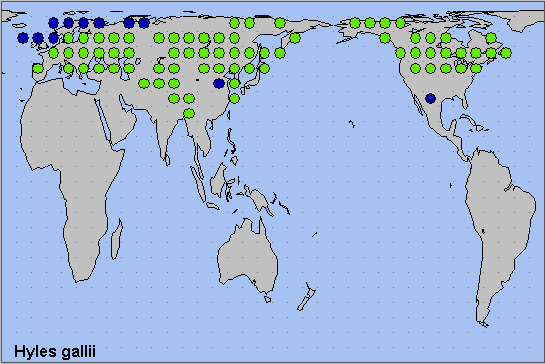
Holarctic; Nearctic and Palaearctic (both eastern and western subregions). Pleistocene refuge: Polycentric -- Holomediterranean, Caspian, Iranian, Turkestan, Mongolian and Manchurian refugia.
 Return to Sphingidae of the Eastern Palaearctic species list
Return to Sphingidae of the Eastern Palaearctic species list